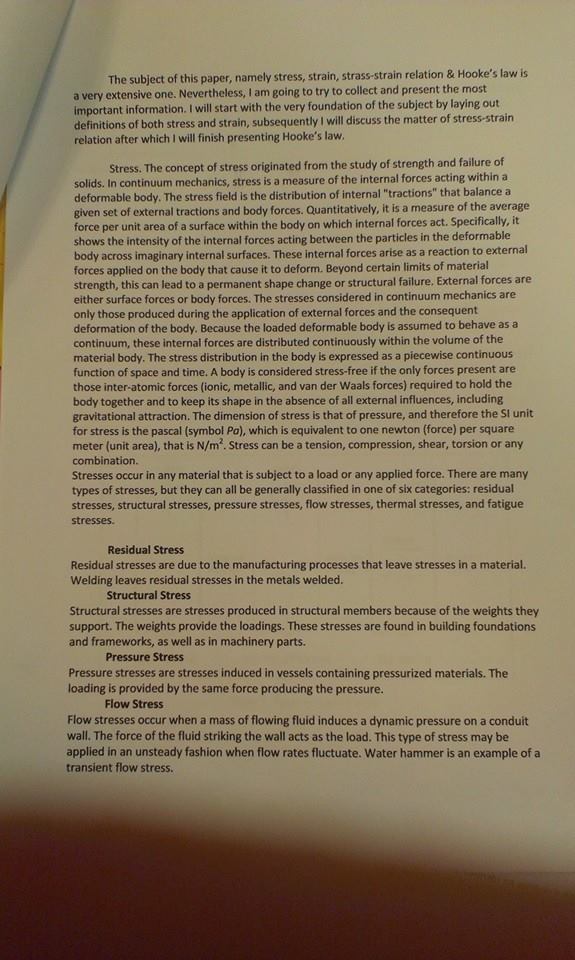10404397R3050797823525‰5148902141299776 n

The subject of this paper, namely stress, strain, strass-strain relation & Hooke's law is a very extensive one. Neverthcles$, I am going to try to collect and present the most Important informatlon. I will start with the very foundation of the subject by laying out definitions of both stress and strain, subsequently I will discuss the matter of stress-strain relation after which I will finish presentlng Hooke's law.
Stress. The concept of stress originated from the study of strength and failurc of sollds. In continuum mechanics, stress is a meosure of the Internal forccs acting within a deformable body. The stress field Is the distribution of internal "tractions" that balance a given set of external tractions and body forces. Quantitatlvely, It is a measure of the average force per unit area of a surface within the body on which Internal forces act. Specifically, it shows the intensity of the Internal forces acting between the particles in the deformable body across imaginary internal surfaces. Thesc Internal forces arise as a reaction to external forces applied on the body that cause it to deform. Bcyond certain limits of materiał strength, this can lead to a permanent shape change or structural failure. External forces are either surface forces or body forces. The stresses considered in continuum mechanics are only those produced during the application of external forces and the consequent deformation of the body. Bccause the loaded deformable body Is assumed to behavc as a continuum, these internal forces are distributed continuously within the volume of the materiał body. The stress distribution in the body Is expressed as a piecewise continuous function of space and time. A body is considered stress-free if the only forces present are those intcr-atomic forces (ionic, metallic, and van der Waals forces) requlred to hołd the body together and to keep its shape in the absence of all external influences, induding gravitational attraction. The dimension of stress is that of pressure, and therefore the SI unit for stress is the pascal (symbol Pa), which is equivalent to one newton (force) per square meter (unit area), that is N/mJ. Stress can be a tension, compression, shear, torsion or any combination.
Stresses occur in any materiał that is subject to a load or any applied force. There are many types of stresses, but they can all be generally classified in one of slx categories: residual stresses, structural stresses, pressure stresses, flow stresses, thermal stresses, and fatigue stresses.
Residual Stress
Residual stresses are due to the manufacturing processes that leave stresses in a materiał. Welding leaves residual stresses in the metals welded.
Structural Stress
Structural stresses are stresses produced in structural members because of the weights they support. The weights provido the loadings. These stresses are found in building foundations and frameworks, as well as in machinery parts.
Pressure Stress
Pressure stresses are stresses Induced in vessels containing pressurized materials. The loading is provided by the same force producing the pressure.
Flow Stress
Flow stresses occur when a mass of flowing fluid induces a dynamie pressure on a conduit wali. The force of the fluid striking the wali acts as the load. This type of stress may be applied In an unsteady fashion when flow rates fluctuate. Water hammer is an example of a transient flow stress.
Wyszukiwarka
Podobne podstrony:
10352554R3050611156877?24339373926714788 n SOME ASPECTS MATERIALS STRENGHT SUBJECT NR 1 Stress, stra
DSCF0062 8Charles XI1 It may well seem that I have chosen as the subject of this lecture a monarch w
44 M. SIKORSKI ABSTRACT The aim of this paper is to review the most widely used techniÄ…ue for studie
The role of accounting in an anti-crisis prevention in smali businesses Summary: The purpose of this
132 I. Steinka I. Steinka TECHNOLOGY INNOVATIONS AS A FACTOR OF FOOD SAFETY Summaiy The aim of this
CCI20121023�16 Stylistyka XVIIIAdministrative Polish and its Variants The aim of this paper is to ma
• The subject of the statement is hidden behind a form of impersonal reflecti
WSTĘP: The subject of our lesson is England. Wc will tell you the most important things about this c
ZOFIA KACZOROWSKA PRECIPITATION IN POLAND IN LONG-PERIOD AVERAGES Summary In the first part of this
00092 ?546ec4ad45fd72a0b658e111513581 91 A Very Simple Set of Process Control Rules FigurÄ™ 2 shows
00339 +06a963b1e1eb1e683a249968625de1 342 McCarville & Montgomery Additionał Considerations The
img012 3 17. In winter months loads stacked outside may be covered in ice and snów, the effect of&nb
więcej podobnych podstron